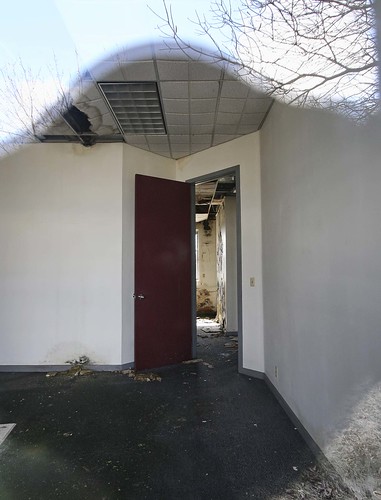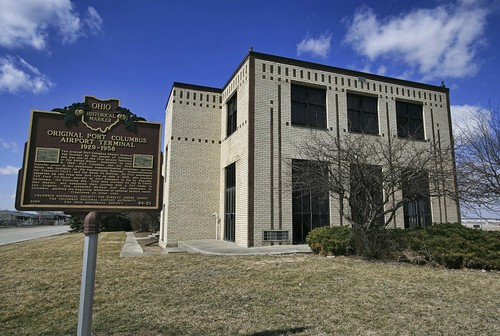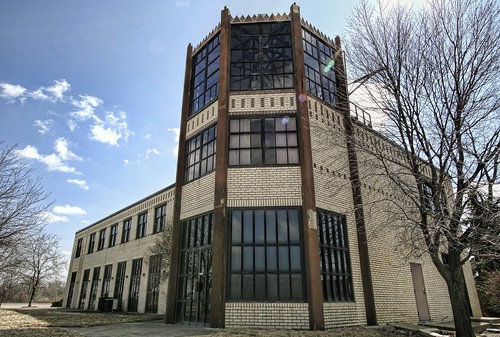 Recently the Columbus Landmarks Foundation released their list of the most endangered historic properties in the central Ohio area for 2014. One of my goals is to visit as many of these places as is possible and photograph them as they stand today, so long as they are able to be visited and viewed.
Recently the Columbus Landmarks Foundation released their list of the most endangered historic properties in the central Ohio area for 2014. One of my goals is to visit as many of these places as is possible and photograph them as they stand today, so long as they are able to be visited and viewed.
At the very top of this year’s list is the Old Port Columbus Airport terminal on the east side. Opened in 1929, it’s a rather attractive Art Deco building, one hailed as “The World’s Greatest Air Harbor” by the city officials who had spent nearly a decade lobbying for it. None other than Charles Lindbergh himself selected the site for the airport, which also—this is fascinating to me—served as a train terminal for the Transcontinental Air Transport New York to Los Angeles air-rail system.

The “street-side” of the building—this is one of the first things seen by rail passengers entering Port Columbus.
It sounds as if travelling such a distance was a bit convoluted back in ’29: For a $351.94 ticket, you’d go from New York to Columbus via the Pennsylvania Railroad, from Columbus to Waynoka, Oklahoma via air, then back onto a train to head to Clovis, New Mexico, and a final leg in the air from Clovis to LA. I’d probably handcuff my luggage to myself lest it be lost! All of that train- and plane-hopping over the course of the required 48 hours sounds exhausting, but of course it was a much different time—travel was a luxurious pleasure and event back then.
(I’ll pause so we can all lean back and fantasize about romantic railcar trips and airplane stewardesses serving cocktails. Ahhhh…)
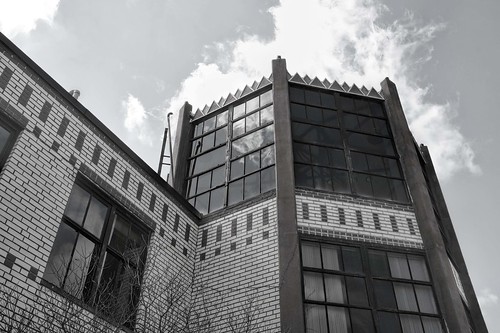
I got a little too cute with the colour here, but plain black & white seemed to stark. Mostly, I just wanted everyone to get a good look at the control tower.
Port Columbus’ opening, on July 28, 1929, was a star-studded event—Lindbergh joined Henry Ford and Amelia Earhart to cut the ribbon, and WWI “Ace of Aces” and Columbus native Captain Eddie Rickenbacker flew in the next day (can you imagine? Forget modern celebrities, give me people who’ve actually accomplished things! And Eddie Rickenbacker, wow! I’d have been beside myself).
Just a year after opening, the train aspect was cut back a bit thanks to the invention of instruments used for night flying as well as the merger of Transcontinental Air Transport & Western Air, which became the familiar TWA. With the advent of WWII, Curtiss-Wright leased nearly 100 acres of the airport for the building of planes; nearly 6,000 were built here. I do not think any of that infrastructure remains, however.

1941 at Columbus, Ohio Airport-CMH By Don O’Brien [CC-BY-2.0], via Wikimedia Commons
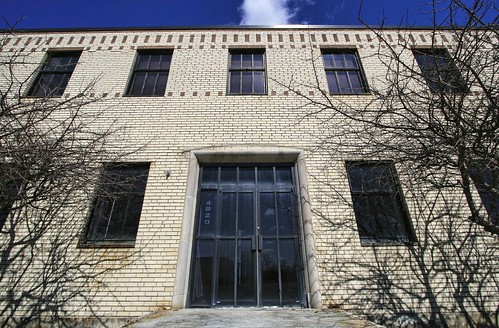
Passengers exiting their train would enter the terminal here. It appears a canopy of some sort has been removed since 1929, but that may not have been original.
Thus begins the sad part of our story, as you no doubt expected. Of course, it is grand that the original terminal even remains—according to the Landmarks Foundation, “The survival of such an early air facility is extraordinarily rare,” and I believe it. Perhaps the building’s good looks, especially that octagonal control tower, have helped it along—also, the Authority wisely chose to renovate the old terminal to be leased out for offices, which is exactly what they did for years. In 1979, Port Columbus celebrated its 50th year of service, and though no longer used as the terminal, Old Port Columbus was added to the National Register of Historic Places.
Unfortunately, it appears to have been empty for some time. The water damage inside is particularly bad, but the exterior of the terminal is in really superb shape. A little sandblasting and repainting of the tower columns and she’d look nearly as good as new!
I do wish there were photographs of the terminal’s interior; I’ve no doubt it was all quite stylish and brimming with Deco glamour. My hope is some of it remains behind the drywall and beneath the carpet.
My penchant for imagining new uses for old buildings being well-known, I can’t help but see the old Port Columbus Terminal as a popular dining spot, the interior restored to its 1929 beauty, complete with al fresco dining on the patio outside those runway-facing doors running across the building. Breezes would blow into the bustling restaurant as diners enjoyed watching planes take off and land. It needn’t be air-travel themed, either.
The second floor could still be used as offices—or perhaps as a home for local veterans in need (I like that more, myself), or the site of new job training for them, with an emphasis on Air Force veterans?
Being listed on the Columbus Landmarks Foundation’s list of the most endangered properties—meaning those most likely to be demolished or lost in the next year—draws our attention to the Old Port Columbus Terminal and the other places in two ways: Bad, in that they are in such danger, but good, too, because it is drawing attention to their plight. My hope, and no doubt that of the Landmarks Foundation and other preservationists, is that an entrepreneur with the means will see one of these places, find an idea sparked, and step in to bring these places to life!
plight. My hope, and no doubt that of the Landmarks Foundation and other preservationists, is that an entrepreneur with the means will see one of these places, find an idea sparked, and step in to bring these places to life!
You know, Cap City (home of gluten-free fish and chips—I almost cried the first time they brought them out for me!) is one of my favourite restaurants here in Columbus…I wonder if owner Cameron Mitchell is interested in a truly exceptional and unique restaurant opportunity near the airport…?
Have a great weekend, dear hearts!
More about the Old Port Columbus Terminal:
History of the Columbus Regional Airport Authority
Old Port Columbus Airport Terminal, American Institute of Architects ArChallenge
Port Columbus International Airport, Wikipedia

